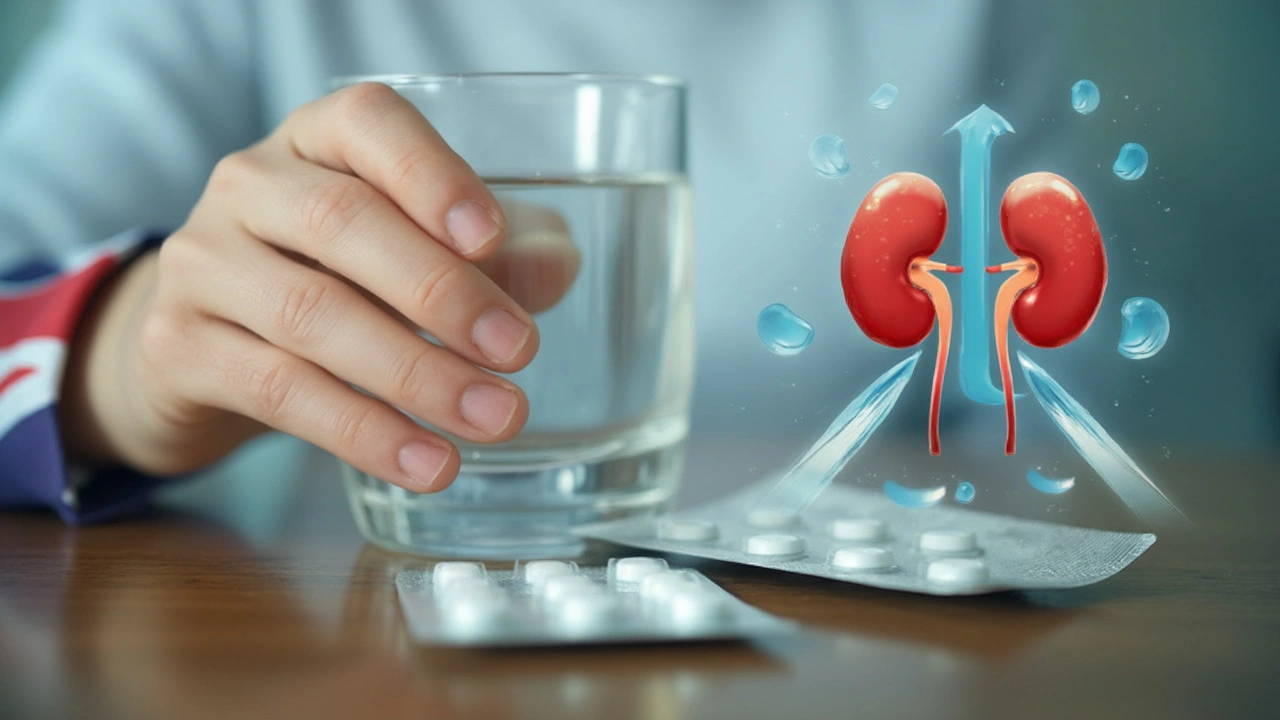Ask most folks if they know someone who uses a water pill, and odds are, they’ll nod before you even finish your sentence. Lasix, or its generic name furosemide, is probably the most famous of all. It’s part miracle, part workhorse, and every bottle comes with its own set of surprises. If you’ve never looked at the label closely, you might just shrug and assume it’s a fancy vitamin. Trust me—it’s not. Lasix can shift pounds of fluid in mere hours, literally making swollen ankles disappear by lunchtime. Sounds great, right? But like those old cartoons with a character running back and forth between the fridge and the bathroom, there’s way more going on under the hood.
What Is Lasix and How Does It Work?
Lasix (furosemide) falls into the category of loop diuretics, which in plain English means it’s a water pill that acts fast and acts hard. The “loop” in its name points to the loop of Henle, a part of the kidney where this drug does its magic. By telling the kidneys to pump out salt and water through the urine, Lasix helps offload excess fluid from the body. This is why doctors love it for things like heart failure, liver cirrhosis, severe kidney disease, and stubborn swelling (edema). I remember seeing a nurse at my local clinic call it “the plumber”—because it clears out pipes that are way too clogged with fluid.
Furosemide’s journey started back in the early 1960s and people haven’t stopped relying on it since. It works within an hour (sometimes in just 30 minutes if given as a shot) and keeps at it for six hours or so—that’s actually why some call it ‘lasts six’ or ‘loss six’. And honestly, when you see the effect in action, it’s no joke. My grandad once took a morning dose and literally weighed two pounds less by dinner—no spinning class needed.
A study published in the Journal of the American Heart Association in 2023 looked at 2,500 patients with heart failure and found that Lasix not only improved their symptoms but helped many stay out of the hospital longer. The big trick is getting the dose right, because too little won’t help and too much can wash out more than you bargained for—think potassium, magnesium, calcium, and more.
The active ingredient here, furosemide, knocks down the body's ability to hold onto sodium (and water follows sodium), so you end up peeing out the fluid your body’s been stockpiling. Ever wondered why Lasix works better in the morning? If you take it before bed, you’ll find out—midnight bathroom sprints are no fun. Especially for folks with heart failure or high blood pressure, the difference can be life-changing.
Common Uses of Lasix
Lasix pops up on everyday prescription lists more than you might think. The most common reason by a landslide: swelling from fluid buildup. Doctors call it edema, you might call it "puffy feet that make shoes impossible." It doesn’t stop there. Heart failure, liver problems, chronic kidney troubles—even some high-blood-pressure cases see Lasix in the mix. For lots of these, the buildup of fluid isn’t just uncomfortable; it’s dangerous. The extra water weighs the heart down, makes breathing harder, and keeps your blood pressure ticking upward.
If you or your parents deal with chronic heart or kidney trouble, you probably already know the ritual: take the pill, wait 30 to 60 minutes, and hope you’re near a bathroom. In fact, the need to track fluid in and fluid out is so critical that many hospitals post bright charts in patient rooms. One Mayo Clinic guide for heart patients actually recommends weighing yourself every morning—if your weight jumps by more than two pounds overnight, call your doctor ASAP. Lasix truly does make that kind of difference.
Some athletes, especially in sports with weight classes, have been known to abuse Lasix to drop water weight fast. That’s risky stuff. The side effects can hit hard and fast, and using Lasix without a real medical need can land you in the ER. In the U.S., it's strictly prescription only, and for good reason.
For kids, Lasix is sometimes used for very specific things, like a short-term fix for a heart or kidney problem. My daughter Isolde had to take it for a spell after a kidney infection years ago, so I’ve seen firsthand how powerful (and touchy) this stuff can be. Kids are a whole different ball game when it comes to dosing—tiny bodies, big reactions.

Side Effects and What to Watch Out For
Here’s the catch: every drug with major power, like Lasix, comes with some strings attached. The most famous ones—frequent bathroom visits and thirst—almost seem like a joke. But losing too much fluid means losing key stuff your body needs to function. Potassium, for instance, is huge. Drop that too far, and your muscles start cramping, your heart rhythm can get sketchy, and you’ll feel wiped out. It’s not rare for doctors to order regular blood tests just to watch those levels. One study from 2022 in The Lancet showed up to 15% of chronic users develop low potassium if not supplementing or eating enough potassium-rich foods.
| Side Effect | Frequency | Comments |
|---|---|---|
| Frequent urination | Very Common | Expected effect |
| Low potassium | Common | Watch for cramps, heart symptoms |
| Low magnesium | Uncommon | Ask about supplements |
| Low blood pressure | Common if dehydrated | Can cause dizziness |
| Hearing issues | Rare | Mainly with IV use or overdose |
Dizziness is another common thing—especially when you stand up too fast after a dose. Blood pressure can dip, and for older adults, that can mean a dangerous fall. Dehydration isn’t just about thirst; sometimes it means dry mouth, headaches, confusion, or trouble focusing. Kids, in particular, can go off balance quickly.
One risk that doesn't get enough attention: hearing problems. It almost never happens with typical oral doses, but if you get too much too fast (especially in hospitals, via IV), it’s possible to have ringing in the ears or hearing loss. Usually, that goes away after stopping the drug, but it's something to flag if you or someone you care about gets a big dose. Liver and kidney patients need extra attention since they're more prone to tricky reactions.
If you notice anything weird—like a thumping heart, random confusion, or heavy fatigue—don’t shrug it off. Make a call, get checked. Doctors usually monitor labs pretty closely with Lasix, especially for people on it long-term. They'll check sodium, potassium, creatinine, and sometimes blood sugar too, because Lasix can bump that up a bit as well.
“The benefit of loop diuretics must always be weighed against the risk of dehydration and electrolyte imbalance. Regular monitoring is not optional—it’s essential.”
—Dr. Geraldine Walsh, Cleveland Clinic, June 2023
Best Practices: Tips When Taking Lasix
If a doc just handed you a Lasix script, there are a few tricks I’ve picked up from real-world experience and conversations in waiting rooms. Number one: timing is everything. Take it in the morning if you can—otherwise, your nights will get interrupted more times than a toddler’s bedtime. If you need a second dose, take it in the afternoon, never after dinner unless you’re pulling an all-nighter anyway.
Stay close to a bathroom for at least two hours after your dose. Seriously, don’t test your luck at a movie theater or stuck in traffic. Make habit of weighing yourself every day at roughly the same time. Rapid weight gains often signal that your body is holding fluid again, maybe because you missed a dose or your condition just flared up. That’s a vital sign more reliable than how your shoes fit.
Keep a bottle of water nearby. Dehydration can sneak up fast, but chugging huge amounts isn’t the fix either—that can dilute those crucial minerals. A balanced diet helps, so think potassium-rich foods: bananas, spinach, avocados, and oranges (my son Rowan says bananas trump all). For some, a supplement might be prescribed, but don’t start that on your own—too much potassium is a problem too.
If you feel dizzy, sit down and wait a bit before standing. Move slowly, especially first thing in the morning. Watch for calf cramps, muscle weakness, or odd heartbeats—these are all warning signs. And let your doctor know about every other med or vitamin you’re taking; Lasix can clash with tons of other drugs, especially those for blood pressure, pain, or blood thinners.
If your doctor asks for labs, get them on schedule. Blood work is how they catch problems before you feel them. Don’t get spooked if there’s a change in your dose from time to time—it’s pretty normal as your body and situation change.
- Take Lasix exactly as prescribed—don’t skip or double doses.
- Report any signs of excess dehydration: confusion, rapid heartbeat, dry mouth.
- If you notice swelling coming back, keep a log and reach out to your team.
- Never mix Lasix with NSAIDs (like ibuprofen) or certain antibiotics without your doctor’s okay.
I had a neighbor who would forget his afternoon dose, think, "well, two at dinnertime should fix it," and wind up dizzy with wild blood pressure. With this medicine—no shortcuts, no substitutions, and no guessing. Write down questions as you think of them, because doctor visits move fast.

Frequently Asked Questions and What to Discuss With Your Doctor
With so many people taking Lasix, it’s wild how often basic questions go unanswered. Can I drink alcohol? (Very carefully—dehydration risk gets worse.) Will Lasix help me lose actual fat? (No, just water. If you lose five pounds overnight, it’s not magic—it’s peeing out fluid.) What if I miss a dose? (Take it as soon as you remember, unless it’s almost time for the next. Never double up just to catch up.)
Should you drive after taking Lasix? Not until you know how it affects you. Some people can feel lightheaded, especially the first few times. Athletes wonder about Lasix for performance or weight cutting. That’s a straight-up bad idea: it doesn't increase muscle or stamina, just drains water, can cause dangerous side effects, and is banned by most sports authorities. Plus, using someone else’s prescription for "bloat" is both risky and illegal.
Pregnancy and breastfeeding? Make sure your doctor knows if you’re expecting. Only use Lasix if your healthcare provider believes the benefits are bigger than the risks—animal studies suggest some risk to fetuses, and for breastfeeding moms, a chunk of the drug passes into breast milk. For kids and the elderly, doses should always be tailored by someone with experience. The same exact dose reacts differently depending on your age, size, and what other conditions you have.
Other things worth talking to your provider about:
- Allergies—especially to sulfa drugs, since Lasix is chemically similar.
- Hearing issues or balance problems—report them right away.
- If you develop a rash, fever, or joint pain—though rare, these can be warning signs of more serious reactions.
- What to do if you're sick or vomiting and can't keep meds down—sometimes the dose needs to be paused.
- How to handle it if you see blood in your urine or notice dramatically reduced urine output.
One last thing: if you ever feel like the medicine isn’t working anymore, don’t just give up—sometimes fluid overload means your body is changing, not that Lasix "stopped working." Tell your doctor, keep notes on your daily weight, symptoms, and doses. It helps more than you'd think.

